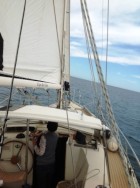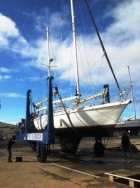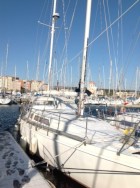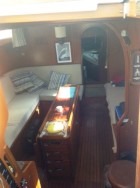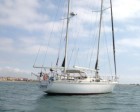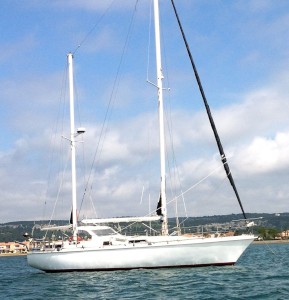Cruising the Med
| Vessel Name: | Cap des Isles |
| Vessel Make/Model: | Amel Sharki #133 |
| Crew: | Jane and Greg Shea |
18 December 2013 | Gruissan, Languedoc Roussillon
Shaking Down May-June 2013
Now that we owned Cap des Isles, we had to get to know her. I scheduled a five week trip from mid May to mid June, with the expectation that the worst of the winter would be over and spring would be well on the way. The plan was for me to go for two weeks, Jane to follow for two weeks and then a week [...]
06 November 2013
Buying Cap des Isles
Having made the offer in January, once again I made some naive assumptions about Med weather, and scheduled the closing for mid-March. I planned to go for three weeks, one to do the survey and finalise the ownership transfer and two weeks staying on board to get to know the boat.
08 October 2013 | Gruissan Languedoc-Roussillon
Finding Cap des Isles
One year after selling the business, I set off to find an Amel Sharki. I had been watching the market on the Internet for quite some time so I knew what was for sale, where and at what prices. The criteria were fairly straightforward, the boat needed to be within a sailable distance from the Med, it [...]
07 October 2013 | Gruissan Languedoc-Roussillon
The Boat
The boat we've purchased for our Med adventures is a Sharki made by Chantiers Amel at La Rochelle, France. She is 12.5 m long by 3.5 m wide, draws 1.7 m and displaces around 10,00 kg. There were about 190 or so made between 1980 and 1989. Cap des Isles iwas built in 1986 and is hull number 133.
02 October 2013 | Gruissan, Languedoc Roussillon
In the beginning....
This really started forty years ago, in Hong Kong, shortly after we were married. A friend asked us to "baby sit" a Dragon class yacht for three months. Jane had never sailed before and I was totally burned out by too much racing as a youngster in Sydney. With the Dragon, I rediscovered sailing for its [...]
Shaking Down May-June 2013
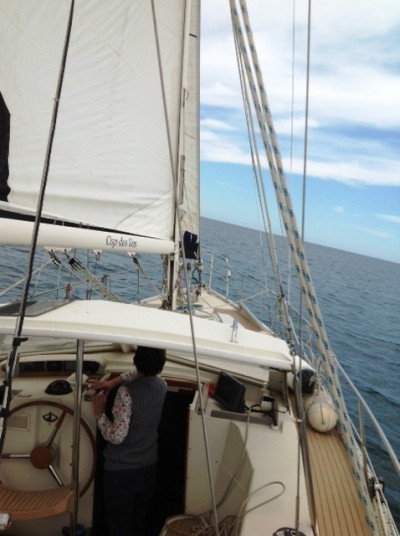
The way we get to and from Gruissan is by TGV from Charles de Gaulle. The train comes south from Paris to Montpelier then turns west and runs along the shoreline to Narbonne. As we made the turn at Montpelier and ran along the coastline you can see the many harbours, protected by substantial seawalls, that line this part of the French Mediterranean. At first I thought I was seeing things but, after about the third harbour, I realized "There are huge waves crashing over the seawalls." I was taken aback by their ferocity and my thoughts of balmy summer breezes turned into an empty feeling in the pit my stomach. There was no way anyone would venture out into that maelstrom. How were we going to get our shakedown cruises with that going on?
When I reached Gruissan and climbed on board, 20 + hours of travelling made battling with nature a job for the next day.
The southerly winds that were causing the mayhem quietened down over the next couple of days but the temperature was far from springlike. It was somewhat warmer than three months prior but a long way from shirtsleeves and forget shorts altogether. To add insult to injury, the Tramontane started to blow again. Same song second verse. The boat was jumping around in the slip, fenders were blowing past the cabin ports, working on deck was extremely unpleasant and the howling of the rigging was non stop. So I busied myself going over all of the inside lockers for the second time. By the time Jane arrived, the Tramontane had subsided, but I was still shell shocked. Two weeks of unrelenting gales in March followed by two more in May. What had I got myself into? Surely there would be a break as it was now June. All of the locals were whining that spring should have started a month previously. Jane arrived on a springlike day with my hopes high for our planned shakedown. We had a rental car so we could get some fairly heavy provisioning done and we got to know all of the supermarkets, hardware stores, chandleries etc.
We were pretty well set when the Tramontane started again. Jane had been on the receiving end of my telephone calls with the Tramontane blowing on my prior trips, but she was quite unprepared for the real thing. It was blowing too hard to even consider venturing out, although some local diehards did so, in full foul weather gear and deeply reffed sails. Their explanation was the the coast was a windward shore so wave conditions were not too bad, so why not? After being pinned down for a week, it calmed down enough that I plucked up the courage to back her out of the slip. No big voyage just get out of the marina and poodle around in the entrance to the port. We had gone about a mile when the motor cut out. I quickly got the anchor down and pondered our first crisis. Not too much detective work, I had forgotten to open the tap from the fuel tank and we had run out of fuel. Fortunately our neighbour in the marina came by and gave us a tow back in to the fuel dock. The task at hand was quite clear, bleed the fuel system. I've done it hundreds of times on Winsome Smile, this one was just four cylinders rather than two. I had a manual and the internet so I followed all of the instructions carefully, several times over. I even E mailed Graham Johnstone in the UK who has a sister ship. His question "Have you located the 'impossible to adjust' bleeding screw?" I said I had and described where it was. His reply "Not that 'impossible to adjust screw' the other one." There were two impossibles? Impossible. Despite my best efforts I could not purge all of the air and had to shout "uncle". I set off , on foot, to find a mechanic who could get us going so we could get back to our own slip. Fairly soon I had located someone who said they could have a man there by about four that afternoon. Somewhat doubtful, I returned to await his arrival. Shortly after four, a Ford Transit van pulled up and an overalled individual introduced himself as the fix-it guy. In rather less than adequate French I explained what I had done, showed him the two "impossible" screws (he smiled knowingly) he poked around a little, had me crank the engine and then proceeded to the injectors. I cranked the engine at his behest while he bled the injectors, something which the manual specifically tells you not to do, in capital letters. He was on board for all of fifteen minutes and the 4-108 Perkins London cab engine was running perfectly again. I happily paid his 30 Euro fee (plus a little pour une verre de vin) and considered it a bargain, much less than for the same service in the US. Now, before we start the engine Jane always asks, "Have you opened the fuel tap."
In the two weeks Jane was there, we managed to get out of the slip three times. On the third time we anchored out for the night. So much for our shakedown cruises.
When Jane left, I had another week to do several projects, put the boat to bed and head home. But the excitement was not over, another adventure awaited.
I ordered a cab to take me from the boat to the station in Narbonne. There is a bus service but if it is not running right on time, you may miss the train and I didn't want to take a chance. The plane to Tampa leaves at 4:15 pm and if you miss the 8:00 AM train, it is the only one direct to Charles de Gaulle, what's next?
So, when the cab did not arrive, I was in trouble. The bus terminus is about a mile away and, with no cab I absolutely had to catch the only bus that might get me to the station on time. Towing my luggage I covered the mile in about ten minutes. The drivers had half a cigarette left on their break when I skidded to a halt at the Narbonne bus, bathed in sweat. The locals looked a little askance but I was happy to be on the bus. The bus trip takes 20-30 minutes and, as we arrived, I jumped off the bus and ran into the station hoping that I still had time to catch my train. There I was, standing in Narbonne station, ticket in hand, staring at the departure screen and panicking because there was no train with my number listed there. I must have looked as bad as I felt because a young lady in her late 20's/early 30's asked me if I was OK and could she help. Where was my train, I wanted to know. It has been cancelled she explained because of the strike. I knew there was a transport workers strike but thought it was only at the airports not country wide. Suddenly she asked, "Would you prefer that we speak English?" What a relief, I understood the problem but sorting out a solution was going to be much easier in English than in French. She was on a Paris bound TGV that was leaving in 15 minutes and she suggested that it was probably the only chance I had to get out of Narbonne that morning. All sorts of questions were running through my head. Could I get all the way to Paris, would I be put off the train for having a ticket on a different train, would I be able to buy another ticket if necessary, would I get to Paris early enough to still get to CDG in time, how did you get from some unknown Paris station through the Metro to CDG????? Her suggestion, get on the train first and worry about the other stuff as it came. Great advice from such a youngie but she knew the lie of the French land better than I. So, along with a lot of others in the same boat, so to speak, I pushed onto the Paris train. At first, there were places to sit, but as we stopped along the way, those seats were claimed by people who had actually bought tickets for this specific train. Pretty soon I was standing up in the buffet car planning the next steps. Step one, snag a stool in the buffet car when someone vacated one since they were not assigned. Step 2 talk to the Chef du Train about the logistics in Paris. I waited patiently, perched on my stool, until a very harried Chef du Train came by with two or three supplicants trailing in her wake. She promised to return once the others were looked after. Sure enough, she returned about fifteen minutes later. No problem with my ticket on the cancelled train, we would arrive at the Gare Lyon at 1:45 and here were the Metro lines to take me to CDG, and by the way, come with me I have a proper seat for you. I have a hard time with the conventional wisdom that the French are rude. My experience, particularly that morning, has been quite the reverse. Maybe the problem is with the visitor rather than the locals?
We arrived in Paris pretty much on time and I headed for the Metro. It took some time to figure out the vending machines and buy a ticket but now I'm waiting for the train to Chattelet, where you change to CDG. I befriended a fellow traveller with a wheelie who looked like he might be going to CDG. I was thinking that we could share a cab if we had difficulty with the Metro. My intuition was correct, he was an Italian, going to CDG and we stumbled around in French yet managed to understand each other. We disembarked at Chattelet and as luck would have it, the train to CDG goes from the other side of the platform. Feeling pretty good, at this point, my Italian companion suddenly appeared and asked me to look at the arrivals/departures screen. I took a look and immediately saw his concern, all trains to CDG today from Chattelet have been cancelled. Oh no!
The next station from Chattelet is Gare du Nord, surely there are trains to CDG from there. A train arrived and the two of us, as well as everyone else on the platform, jumped on. We would have looked like right charlies if we had been left on the platform when everyone else knew better than to wait for a cancelled train. Gare du Nord is huge and we had no idea where to go. We tried following the signs but they were very confusing. Two elderly black guys saw our plight and came to our assistance.
"The train to CDG, you have to take the escalators over there and go upstairs." Off we set, but which of the several escalators? As we hesitated at the foot of the escalators, our good Samaritans, who must have been watching our quandary, approached shouting "the one on the right." More rude French people. Up we went, running now, onto a platform where there was a train apparently going to CDG. As soon as we could find a carriage that wasn't already packed solid with passengers, we and our bags squeezed on board. The train set off and as soon as we were settled I checked with one of my fellow sardines. Yes, he confirmed, this was the train to CDG, and how long, about 45 minutes. I was going to make it!!!! When I finally arrived at the Delta counter, the agent who checked me in said: "You look really harassed." I did not bother to give her the long version, I just said; "I started very early this morning and had a difficult trip." Then I added: "But the French were very helpful." Her eyebrows shot up but she did not respond, what a loaded statement, discretion was obviously the better part....
The plane left on time but there were delays in Atlanta and I arrived home at 5:30 AM, twenty eight and a half hours. You can get to Australia faster than that.
Buying Cap des Isles

What I did not take into account was the Tramontane, gale force winds that blow for days on end, particularly in the winter. These winds are found all around the Med, their names change by location, Mistral, Bora, Levanter, Sirocco etc. Without knowing it, I had encountered the Tramontane after the snowfall in January. I thought it was just windy then, I didn't realize that it was a regular fixture and had a name.
I arrived in Gruissan ready to have the boat lifted for its pre-sale survey on a Monday morning. "Too windy" I was told "maybe Wednesday, the Tramontane is blowing." Fortunately, things had quietened down by Wednesday and the boat was hauled and surveyed on a windless and relatively warm winters day. That night I moved aboard.
It was cold in the mornings but there was an elderly space heater on board so, with shore power, I could warm up the cabin somewhat. Then the Tramontane started again. It was blowing 30-40 knots on the stern quarter which meant the boat was trying to turn sideways in the gusts. The springlines would pull her up short with a jerk, sometimes violently enough to knock you off balance. The motion was somewhat nauseating. Seasick at the dock!!!! The gusts were strong enough that, from time to time, fenders would be blown up above the deck and they would fly past the cabin windows. The noise was horrendous with the singing of the rigging of the 400 boats in the marina overlaying the wind itself. Additionally, the creaking of the mooring lines as they stretched back and forth through their fairleads made the aft cabin a sleeping challenge. On a couple of nights I actually put on my noise cancelling headphones and moved out of the aft cabin, just to try to get some peace and quiet.
The Tramonatne came and went two or three times while I was on board. The proportions were probably 75/25 Tramontane/non-Tramontane. I felt like those stories of polar explorers where the wind shrieked around their tents and they couldn't go outside for days on end. Not quite that bad but I was ecstatic when the wind dropped, the noise dissipated and I could work on deck.
Learning a new boat is always a lengthy business and there was a lot to learn about Cap des Isles. There was so much "stuff" that it took me five days just to explore all of the storage lockers.
There was one thing I found disconcerting in this process of taking ownership in the European milieu and that was the survey. You have to have one for insurance coverage but the processes on either side of the Atlantic are very different. A surveyor in the US is very knowledgeable about the "nuts and bolts" of individual boats and their systems. A US survey is a critical appraisal of the boat and its systems and is typically very detailed. Sellers know this and will often correct defects so that there are as few criticisms as possible. The European survey is not at all critical. It is just a series of check lists that are cursory, at best. I thought I was going to get a critique that would be the framework for an upgrade plan. What I got was pretty well useless, long on form short on function, and I felt I received very little value for the 1,000 euro cost. But, when in Rome.....
At the end of three weeks I headed back home, with a plan to come back mid May, with Jane, for the next steps and a shakedown cruise
Finding Cap des Isles
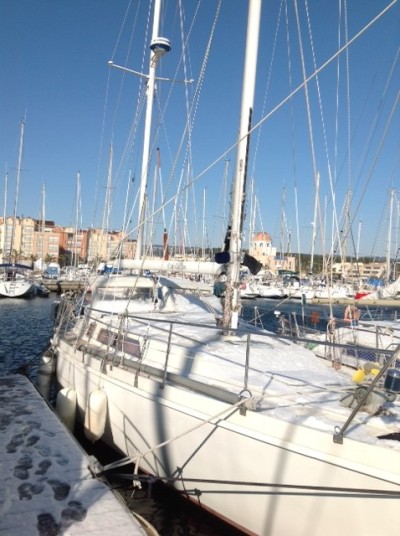
I knew that my search would have to be in winter to avoid the "spring rush" when sailors thawed out as the weather warmed. I decided to start looking, in earnest, in January 2013. I thought that would give me time to run at it a couple of times, if necessary. Since I wanted roller furling, this limited me to boats built from 1986 to 1989, of which there are less than 100. As 2013 dawned there were three candidates, all around Marseille. In retrospect, I made two mistakes in choosing January. Living in Florida, one forgets how grey, miserable and cold it can be in northern climes in January. You forget that Madrid and Rome are on about the same latitude as Chicago and Milwaukee, and who wants to go to Illinois or Wisconsin, in January. My second mistake was to choose the worst winter that the Europeans had encountered in decades.
Naively I blocked off five working days towards the end of January 2013 and set off to see two and maybe three Sharkis.
The first one I saw was the only sloop rigged Sharki ever built. Amel boats are always ketches. It was built specially for Henri Amel's attorney, in Switzerland. Sailing on a Swiss lake, the attorney wanted a taller mast and bigger sails. Henri acceded to his wishes but I wondered who paid for the redesign because you don't change rigs so dramatically without revisiting the design calculations and ballast specs. I was excited to see this "one off" especially as I am not a fan of the ketch rig. What a disappointment. The boat was a "fixer upper." My reading was that the elderly owner (it had changed hands since the days of the attorney) had used it as a power boat, installing a 100 HP turbocharged engine in place of the original 50HP one and then simply driving his grandchildren around the Med, each summer. Apart from the very expensive engine, it looked like nothing else had been spent on the boat. It seemed like the boat had been "ridden hard and put away wet." A big let down.
The second boat was in much better condition and had one of Amel's early attempts to convert manual furling of the main to electric. It was in generally good condition but, like the sloop, not much had been spent on it during the last 25 or so years. I decided that the cost of getting her back up to scratch was going to be very expensive and was not reflected in the asking price. I took that one off the list.
I had not actively pursued boat #3 because it was somewhat further away, close to the French/Spanish border and I thought I would find what I wanted in one of the first two. Bummer. But I still had a couple of days in hand so, rather dejectedly, I set off in pursuit of boat #3. The Europeans are not known for their attention to the customer's needs and it was almost impossible to contact the broker and get him to return my calls. Several times I was ready to quit but I thought "What else are you going to do for the next two days?" To add insult to injury, it had been snowing, something I never expected in that part of the world and my rental car was woefully inadequate at coping with the slipping and sliding. Finally I made an appointment to view boat #3.
The snow had receded and I (halfheartedly) set off to Gruissan, where boat #3 was located. I had looked up Gruissan in Google maps at the hotel but once I left the hotel network, I just had that page on my I pad. Driving towards Spain I listened to the weather report on the car radio. Although it didn't look like it, the forecast was for snow. I decided my French was inadequate, I couldn't see anything that looked like an impending snowstorm. Fifteen minutes later, wham, a blizzard. I was learning about the vagaries of the Languedoc-Rousillon weather. More about that later. To cut a long story short I reached Gruissan about 6:45 PM for my 5:00 PM appointment. The snow was coming down, people were hurrying home, it was pitch black by then, cold and miserable. Several times I thought of throwing in the towel. No boat was worth this. My I pad page was not fine enough to give me good directions, I asked passers-by but they were not much interested in some foreigner, with bad French, who was stupid enough to be asking for directions in the middle of a snow storm. I did not have a cell phone to call the broker but finally I shouted uncle. I figured I was somewhere near the boat and there was a small "corner grocery" so I went in and asked to borrow the proprietor's cell phone. I called the broker and was astounded to find he spoke English. Wait, were his instructions.
After about twenty minutes a 30-something transplanted Breton arrived. Off we set in the snow to the marina. It was less than 100 yards away. I had almost found it on my own.
We climbed aboard, taking off our snowy shoes before entering the cabin. So there we were, the broker and I, in our wet socks, in an unheated cabin shivering up a storm (excuse the pun). I made a quick inspection and the boat seemed to be what the other two were not. Generally in good condition. A full array of electronics. Enough stuff on board that you felt you only needed to bring your toothbrush. I thought "You may have found your boat."
Realizing that I needed to take a better look in daylight, I said as much to the broker and asked if there was somewhere I could stay the night. His reply elicited a wry smile from me, "You don't have a choice" he said, "We have received 10 cm of snow and the roads out of town have been closed. This is the first time we have seen snow in Gruissan in fifteen years." So, off to the Best Western I went.
I woke the next morning to bright blue skies (see photo) and a howling wind. I knew immediately what I would find when I stepped out the door. Wind chills below zero Fahrenheit and snow that had turned to ice. If I hadn't been so anxious to see the boat again, I would have happily snuggled back under the covers. Braving the arctic cold, the broker and I returned to Cap des Isles. I went through my check list and decided that I would make an offer subject to survey. The offer was accepted, a tentative date in March was chosen for the survey and late that day I drove back to Aix for an early morning flight, the next day, from Marseille. Interestingly enough, as I drove out of the hotel to go to the airport, the thermometer in the car showed minus 7 C. I thought the Med was supposed to be balmy Maybe it wasn't and maybe I was.
Interestingly, both of the other boats were sold by spring, in fact I believe there was an offer on the sloop the very next week. Even more interesting is that, during the nine months that have elapsed since that snowy day in Gruissan, there have been no more Sharkis that fit my criteria, for sale. When the three I saw were sold, that was it. If I hadn't bought Cap des Isles when I did, who knows when I would have found another opportunity, and, at this stage of life, waiting for opportunities is probably not the best use of one's time.
The Boat
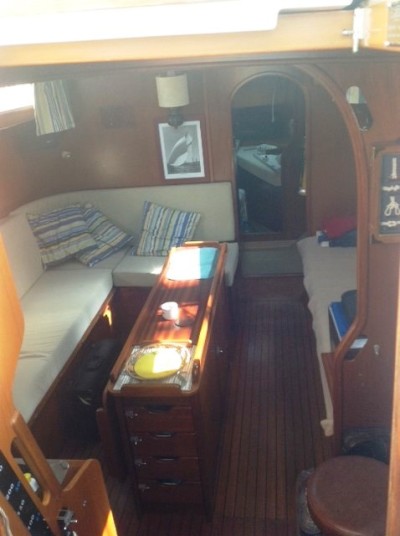
She is no racing boat but has a modern underwater shape and sails very acceptably. The design parameters were for a boat that a couple could comfortably sail around the world, not a race winner. As such she is very comfortably equipped with a double cabin in the stern, two berths in the bow, a roomy galley/main cabin and a single head. The engine is a 50HP Perkins, the same engine that was used in the ubiquitous London cabs.
What is unique about Amels is that Henri Amel took a holistic approach to design. He thought through every detail, taking into consideration the needs of a cruising sailboat. There are some very quirky things about the boats but they are not there by happenstance. Most yacht builders leave it to the owner to customize the boat, often a difficult thing to do after the boat is completes. Henri decided he would build a complete boat, from soup to nuts, and if his approach was not to your liking, go somewhere else. Henri was definitely a character. Stowage is a good example of Henri's thought process. Stowage is always an issue in a small boat. Where do you put all the accouterments of a comfortable, on-board life? Most cruising boats do not have enough stowage. Wide open cabins and lots of open space sell well and, as a result, stowage on most cruising yachts is woefully inadequate. To compensate cruisers typically have lots of stuff on deck, lashed to the rails, piled on top of the cabin and generally look like a floating hodge podge. Cruising Amels seldom have this clutter because Henri understood the stowage needs of a cruising boat and built cavernous stowage into the boat. There is no need to use the decks, cabin top etc. there is adequate space within the boat. Accordingly you don't worry about an errant wave sweeping the hodge podge over the side nor do you have to climb on or around it when moving about on the boat.
The sails on Cap des Isles are all roller furling (easy on us old folks) and the jib has an electric furler that uses a truck starter motor (easy to replace). Amel construction is also unique. Most boats come in two pieces, a hull and deck, bolted together. Amels start off like that but then they fibreglass over the bolted joint so that the boat becomes one complete structure (a 12.5 m egg shell).
By now you get the picture. You either accept Amels for what they are or go elsewhere. One broker told me they only appeal to about 5% of the market and I can believe it. In the US they are looked at as stodgy, in Europe they are admired. I get the feeling that the Europeans think about them in a "Mercedes-Benz" sort of way, classy, solid, reputable, comfortable. What you buy when you are no longer looking for an adrenal rush and where a place to store a couple of cases of wine has become a priority.
Jane's underlying philosophy is "no camping". If we are going to spend several months a year on board, she wants it to emulate a summer cottage and "roughing it" is not part of the equation. Already the galley is set up to her exacting standards, a freezer has been added, all of the cushion covers have been replaced, curtains are next, new cockpit cushions are in the works.
We are looking forward to a boat which can carry us comfortably and safely through the nooks and crannies of the Med, and yet still be well within the physical limitations of two aging geezers (did I mention the oversize windlass?)
In the beginning....
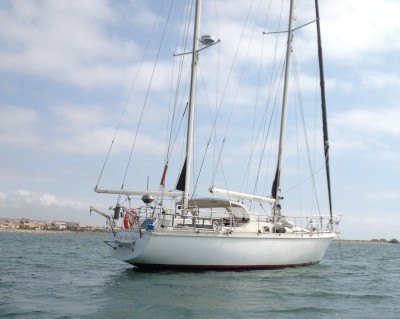
Sailing went on hiatus when we moved to Galesburg but on our return to Hong Kong, without spousal consultation, I came home one Saturday afternoon the third owner of a Cheoy Lee 26. This was not a good move, on several fronts, not the least of which was that one third of the boat's ballast had never been installed. I corrected this oversight, a not insignificant undertaking, and we cruised her throughout Hong Kong waters for three years. The day after I sold her we took off from Hong Kong for a charter in the Whitsundays on the Great Barrier reef. Bareboating there was in its infancy and we were the first "international" charters that the fledgling Moorings group had booked.
After moving to Illinois, buying boats was not on the agenda, but we met Sheila and Dick Alcock, who owned a Tartan 34. The Alcock's generously allowed us the use of the boat and we ferried the boat through Lake Michigan and Lake Huron, some of the loveliest cruising grounds we have encountered. During those Ilinois years, we also chartered in the Bahamas and the BVI.
When it came time to bid mid-west winters adieu, in the late '90's, a house in warmer climes and a live-aboard sailboat were both on the table. I had decided on the make of boat, a French boat from Amel, in la Rochelle. We went to the factory to view the Amel philosophy in practice but a new one was way out of our price range. With a lowball offer I tried to steal a used 46 ft Amel at the '97 Annapolis Boat Show but (fortunately) I lost out.
No sailboat but a house in Florida led to the next boat, a 30 ft S2, that we have now had for fourteen years. We have cruised her extensively on the west coats of Florida and she has enabled us to refine our cruising skills.
Which brings us to early 2012 when I sold my shutter manufacturing business and the possibility of cruising in retirement became a possibility.
